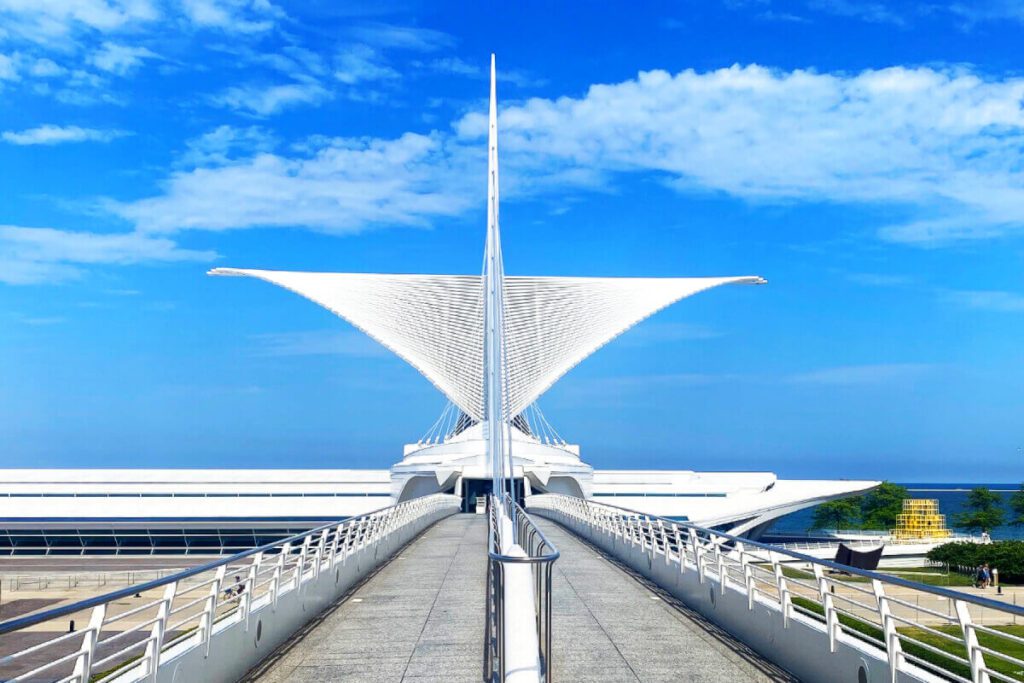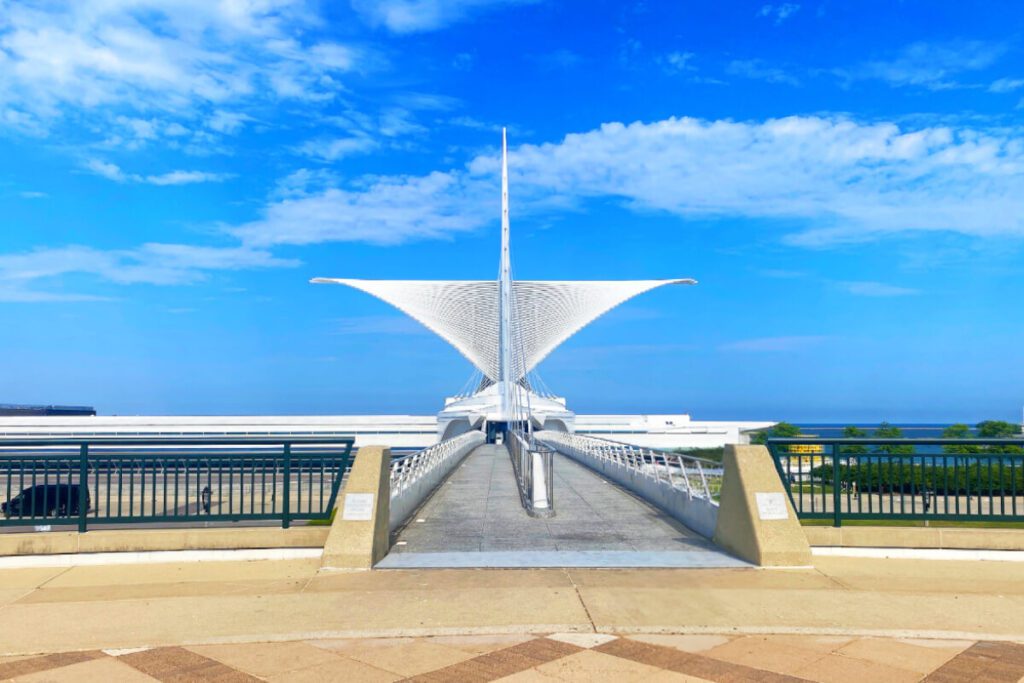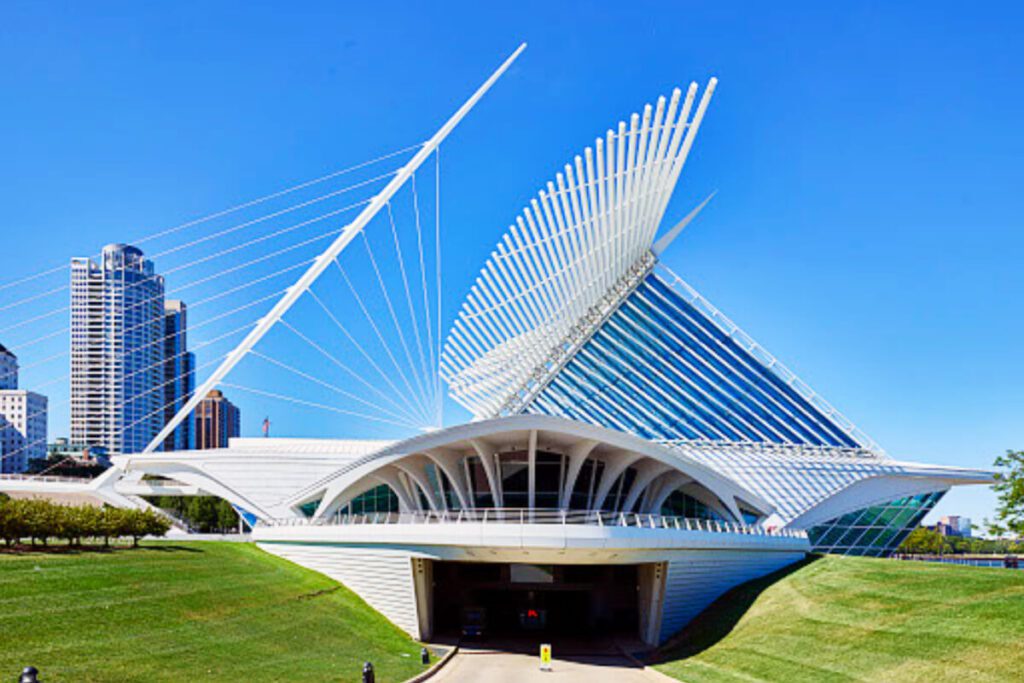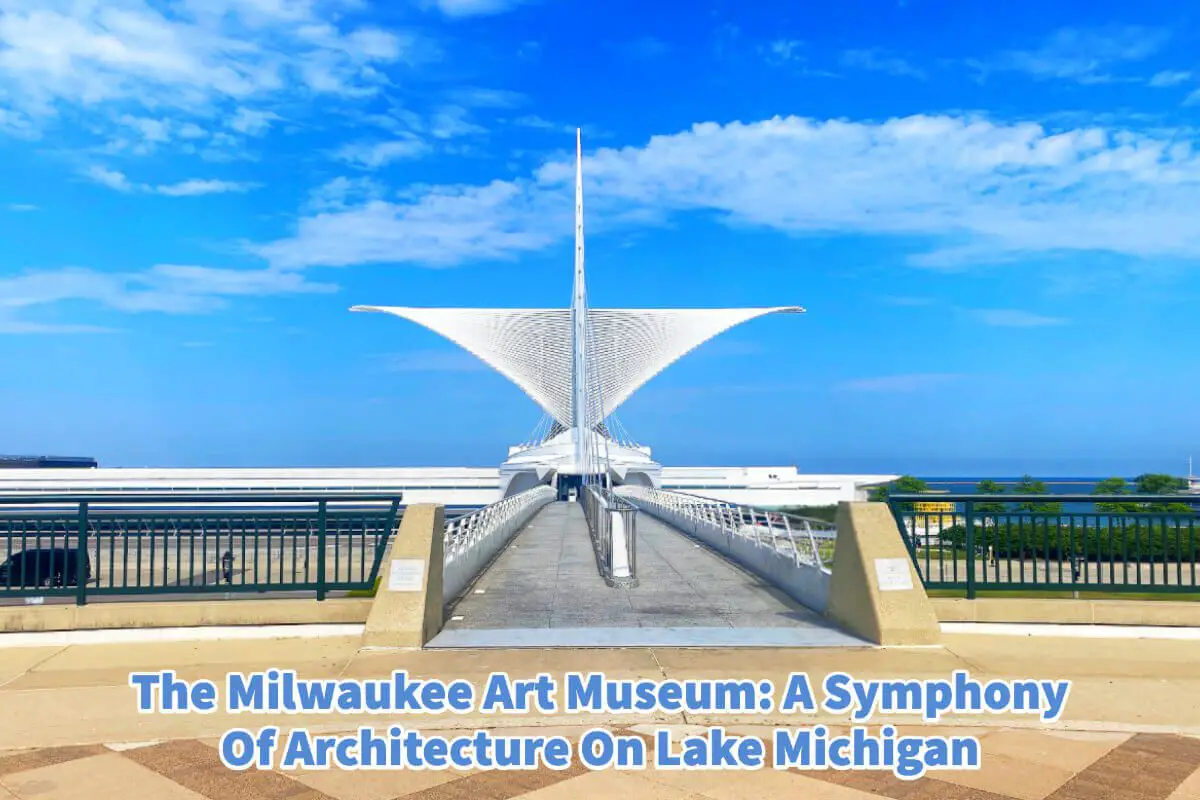Installed along the picturesque shores of Lake Michigan, the Milwaukee Art Museum stands as a beacon of artistic expression and architectural brilliance. Coming from Milwaukee and spending time sailing on Lake Michigan, the art museum symbolizes this great city.
At the heart of the Art Museum lies the Quadracci Pavilion, an iconic sculptural addition designed by the visionary architect Santiago Calatrava. Inspired by Eero Saarinen’s original building, the city’s topography, and Frank Lloyd Wright’s Prairie-style architecture, Calatrava crafted a masterpiece that seamlessly integrates cutting-edge technology with old-world craftsmanship.
Table of Contents
The Milwaukee Art Museum – A Magnificent Architectural Masterpiece
At the core of the Art Museum is the Quadracci Pavilion, a symbolically sculpted structure conceptualized by the forward-thinking architect Santiago Calatrava. Eero Saarinen’s original edifice stirred his design, the city’s landscape, and Frank Lloyd Wright’s Prairie-style architecture.
Calatrava meticulously melded state-of-the-art technology with traditional artisan skills to create a masterpiece that stands out yet flawlessly coexists with its historical surroundings.
Join us on a journey through this cultural gem as we explore the Quadracci Pavilion, the war memorial, and the enchanting gardens that make the Milwaukee Art Museum an architectural marvel on the shores of Lake Michigan.
The Quadracci Pavilion: Milwaukee Art Museum

A Symphony of Design As one steps into the Quadracci Pavilion, they are greeted by the grand reception hall, Windhover Hall. With its flying buttresses, pointed arches, ribbed vaults, and a central nave topped by a 90-foot-high glass roof,
Windhover Hall is Calatrava’s interpretation of a Gothic cathedral. This awe-inspiring space, large enough to accommodate an average-sized, two-story family home, features floor-to-ceiling windows that offer breathtaking views of Lake Michigan. The Baumgartner Galleria and Schroeder Galleria are adjoining the central hall, with two arched promenades providing expansive lake vistas and downtown Milwaukee.
One of the most recognizable features of the Quadracci Pavilion is the Burke Brise Soleil, the museum’s signature wings. Forming a moveable sunscreen with a remarkable 217-foot wingspan, the brise soleil comprises 72 steel fins ranging from 26 to 105 feet long, weighing 90 tons.
The wings open or close in a mesmerizing 3.5 minutes, responding to the wind speed and direction. This remarkable feature serves a functional purpose in controlling the light level within the building and symbolizes the city’s spirit and openness to visitors.
The Quadracci Pavilion As A Symbol Of Milwaukee
According to Santiago Calatrava, the Quadracci Pavilion’s design is a direct response to the culture of the lake, taking inspiration from sailboats, the weather, and the sense of motion and change. The brise soleil, in particular, represents the building’s formality, functionality, symbolism, and iconic status.
Its completion completes the composition of the museum, while its ability to control the level of light serves as a functional element. Symbolically, the brise soleil welcomes visitors, creating a lasting and memorable image for the museum and the city of Milwaukee.

Eero’s innovative design drew inspiration from the abstract geometry of modern French architect Le Corbusier. The building, a concrete, steel, and glass cruciform floating on a pedestal, comprises three major components: the base, which houses the art museum; the memorial court with a pool, surrounded by polyhedron-shaped piers framing breathtaking views of the lake and sky; and the superstructure, cantilevered outward, containing meeting halls and offices for veterans’ organizations.
The War Memorial Center: A Tribute To The Living And The Dead
Adjacent to the Quadracci Pavilion, the War Memorial Center holds significant historical and architectural importance. The arts complex, commissioned after World War II, was initially conceived by Finnish architect Eliel Saarinen and later completed by his son, Eero Saarinen.
One of the most notable features of the War Memorial Center is the western face adorned with a memorial mural created by Wisconsin artist Edmund Lewandowski. The mosaic, composed of 1.4 million pieces of marble and glass, stands as a solemn tribute to the sacrifices of the fallen.
With its dramatic entryway from the central courtyard and three extensive exhibition galleries, the original Museum expanded in 1975 when architect David Kahler designed an addition that greatly expanded the gallery space. This expansion solidified the Museum’s standing as a vital cultural institution within the city.

Dan Kiley’s Enchanting Gardens
Welcoming visitors and providing a tranquil separation between the bustling city and the serenity of the Museum is a series of captivating gardens designed by renowned landscape architect Dan Kiley.
Kiley’s collaboration with the Quadracci Pavilion and the War Memorial Center was instrumental in integrating the site as a whole, seamlessly blending the formal articulation of Eero Saarinen’s modernist design with the organic patterns found in Calatrava’s Pavilion and the soaring bridge and brise soleil.
Running parallel to the Quadracci Pavilion is a rectangular garden that spans 600 feet by 100 feet. This formally organized garden is divided into five lawns by 10-foot-tall hedge lines.
At either end of the grassy expanse, two paved plazas with fountains rise to 35 feet, creating a stunning visual centerpiece. A narrow water channel connects the plazas, running the entire length of the garden. Water jets within the channel create a mesmerizing 4-foot-high water curtain, dancing and sparkling with fiber optic lights.
Other sections of the Museum’s landscape are brought to life by a grove of linden trees and a stand of Sargent crabapple trees, accompanied by a delightful periwinkle ground cover. These carefully selected elements contribute to the overall harmony and beauty of the gardens, providing visitors with a serene place to pause and immerse themselves in the tranquility of the surroundings.
The gardens bear the name of philanthropist Michael Cudahy, whose generous donation made the landscape design possible.
The Milwaukee Art Museum, with its Quadracci Pavilion, War Memorial Center, and enchanting gardens, stands as a testament to the power of architecture to inspire and captivate. From Santiago Calatrava’s visionary design that harmoniously blends modernity with the city’s cultural heritage to the Saarinens’ innovative and thought-provoking memorial and Dan Kiley’s masterful landscape architecture, every element of the Museum evokes a sense of awe and wonder.
The Quadracci Pavilion, with its grand reception hall, Windhover Hall, and the iconic Burke Brise Soleil, has become a symbol of Milwaukee, reflecting the city’s spirit and openness to visitors.
The War Memorial Center stands as a solemn tribute to the sacrifices of the fallen, seamlessly integrated with the museum’s artistic offerings. And finally, Dan Kiley’s enchanting gardens provide a tranquil oasis, perfectly complementing the architectural marvels while harmonizing with the natural beauty of Lake Michigan.
As visitors explore the Milwaukee Art Museum, they are treated to a remarkable art collection and immerse themselves in a symphony of architectural brilliance. The museum’s role as a cultural landmark and symbol of Milwaukee’s identity is firmly established, drawing people from far and wide to experience the fusion of art, design, and nature.
The Milwaukee Art Museum is not just a repository of artistic treasures; it is a testament to the transformative power of architecture and a source of inspiration for future generations.
Anita Louise Art is dedicated to art education, great artists, and inspiring others to find and create their art. We love art that uplifts and inspires. #ArtToMakeYouSmile! #ArtToMakeYouHappy!
If you are interested to see any of my art, you can find out more by clicking here. If you are interested in what inspires me and my paintings, you can discover more by clicking here.
We have a free newsletter and would love you to be part of our community; you can subscribe to the newsletter by clicking here. If you have any questions, I would be happy to talk to you anytime. You can reach me, Anita, by clicking here.
Subscribe to our Anita Louise Art YouTube Channel with great videos and information by clicking here.
Join us for our podcast “5 Minutes With Art.” Spend just 5 minutes a week with us to discover and learn about great art and artists. You can find out more about our podcast by clicking here.
Related Questions
Discovering Van Gogh: Van Gogh Museum Amsterdam
The Van Gogh Museum in Amsterdam is a world-renowned cultural institution that attracts art lovers and enthusiasts from around the globe. It is home to the most extensive collection of works by the legendary Dutch artist Vincent van Gogh. Visitors can explore Van Gogh’s fascinating life and career through a diverse collection of over 200 paintings, 500 drawings, and 700 letters. The museum constantly has new and exciting collections that also reflect upon the work and life of Vincent Van Gogh.
By clicking here, you can discover more by reading Discovering Van Gogh: Van Gogh Museum Amsterdam.
Clyfford Still Museum In Denver, All About
The best place in the world to see and get inspired by Clyfford Stills and his artwork is the Clyfford Still Museum in Denver, Colorado. The museum has the bulk of the Abstract Expressionism artist’s works of art housed at their museum. The museum only shows and displays works of art by Clyfford Still.
By clicking here, you can learn more by reading Clyfford Still Museum In Denver, All About.
Louvre Museum Facts, Our Top 7 Facts
The Louvre is the largest museum globally; it was once built as a fortress to protect the city of Paris. Under the French Republic’s rule, General Napoleon expanded the Louvre’s collections. One of the most important paintings at the Louvre is the Mona Lisa painting by Leonardo da Vinci.
By clicking here, you can discover more by reading Louvre Museum Facts, Our Top 7 Facts.

